Fujifilm X-T100 – At a glance
- £619 (with 15-45mm XC kit lens)
- 24.3MP APS-C CMOS sensor
- ISO 200-12,800 (expandable to ISO 100-51,200)
- Up to 6fps continuous shooting
- 3in, 1040k-dot 3-way tilt type LCD touchscreen
- 4K Burst Photo
- Wi-fi, and Bluetooth connectivity
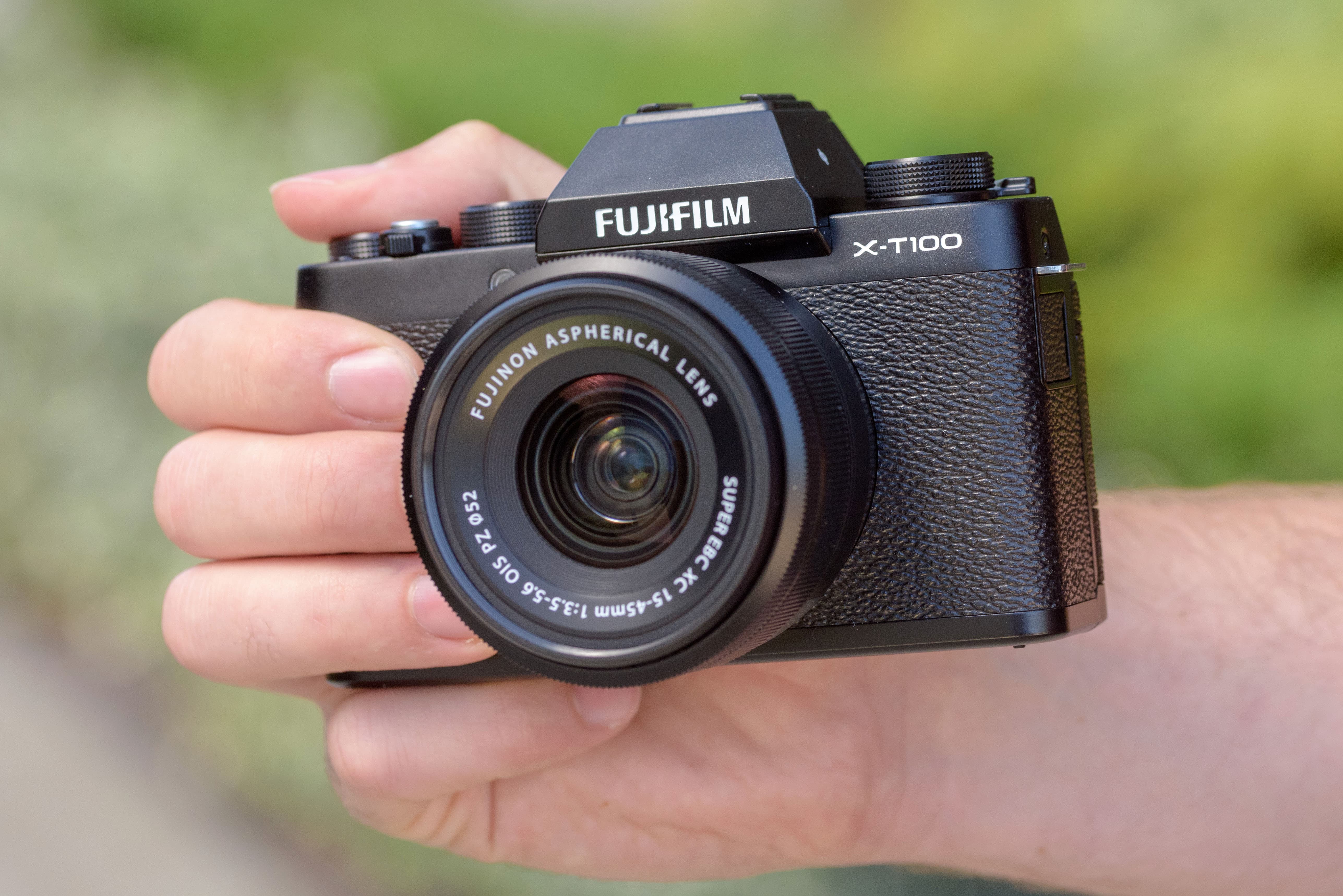
Here the X-T100 is pictured with Fujifilm’s 15-45mm f/3.5-5.6 XC OIS PZ kit lens
In the early days of the X-series, Fujifilm were all about targeting professionals and enthusiasts to their system. After the release of the X-Pro1 in 2012, the X-E1 arrived, which was a slimmed down, more affordable alternative. This was the first sign of Fujifilm expanding their line up to attract photographers who loved the appeal of the small system, but were working to a stricter budget.
Over the years we’ve seen Fujifilm add its entry-level X-A series, develop its hugely successful X-T series and launch its recent X-H series, all of which compliment the much-loved X100-series where the X-series first began.
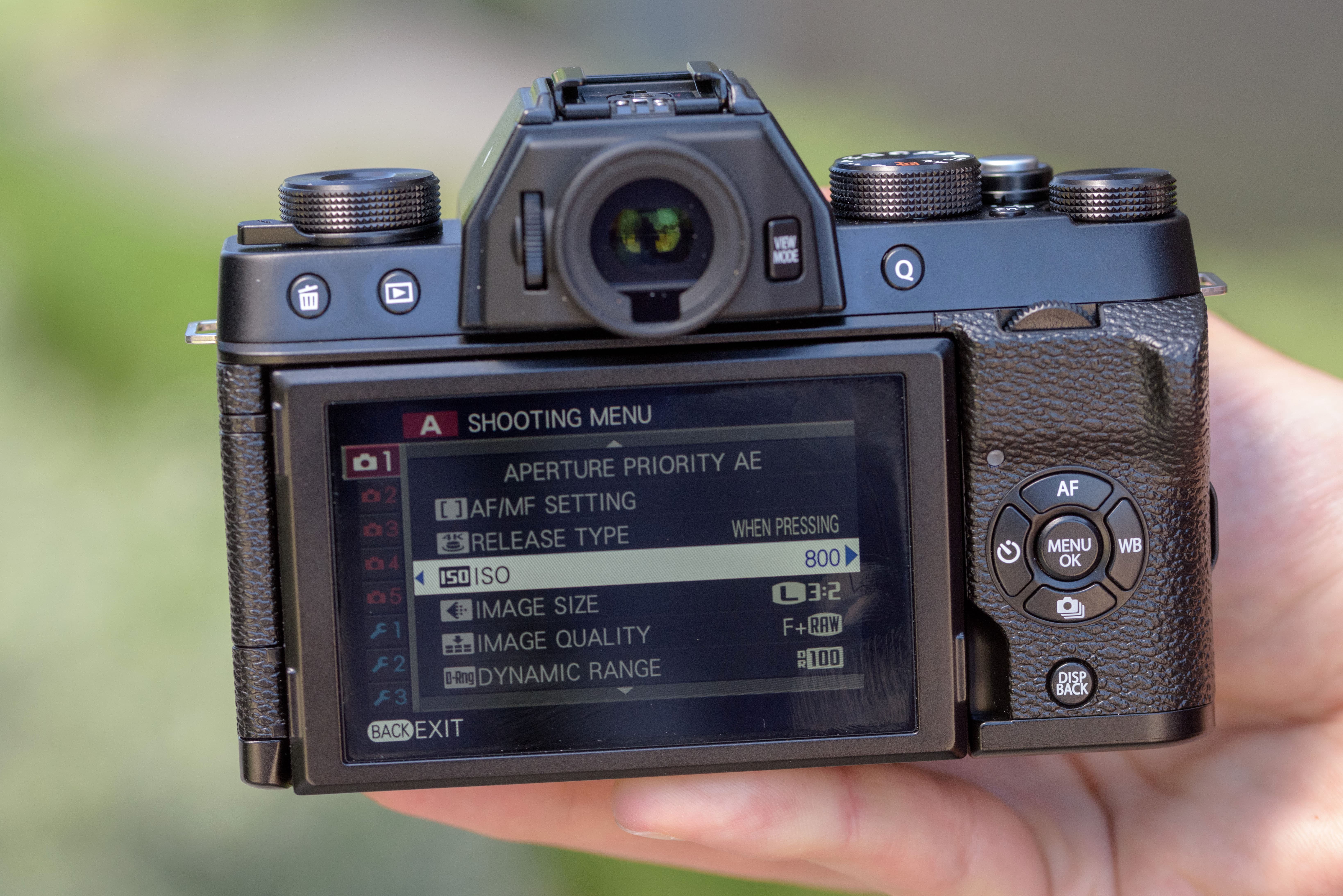
The X-T100’s menu system is rather dated compared to more advanced X-series cameras
Today, Fujifilm’s X-series provides a healthy range of models for all types of user, from beginner to professional, and continues to flourish with the introduction of new models like the X-T100. Designed to sit above the X-A5, but below the X-T20, it’s aimed at novices who desire an electronic viewfinder and tilting screen at a more affordable price than any previous X-T series camera launched to date.
Fujifilm X-T100 – Features
The X-T100 is equipped with same 24.2MP APS-C CMOS sensor that Fujifilm’s X-A5 uses. Like its entry-level cousin, this sensor employs the more traditional Bayer colour pixel array rather than the proprietary X-Trans pixel array found in more advanced Fujifilm cameras higher up in the range such as the X-T20.
The welcome news is that the sensor benefits from the addition of on-chip phase-detection, which the otherwise similar 24.2MP sensor within the older X-A3 didn’t. The sensor isn’t paired with Fujifilm’s X-Processor Pro. Instead, it teams up with the same newly developed image-processing engine that the X-A5 has. It can’t rattle out a continuous burst at 14fps like the X-T20 and despite having a mechanical and electronic shutter, it shoots at a more pedestrian 6fps and 3fps in its high and low burst modes.
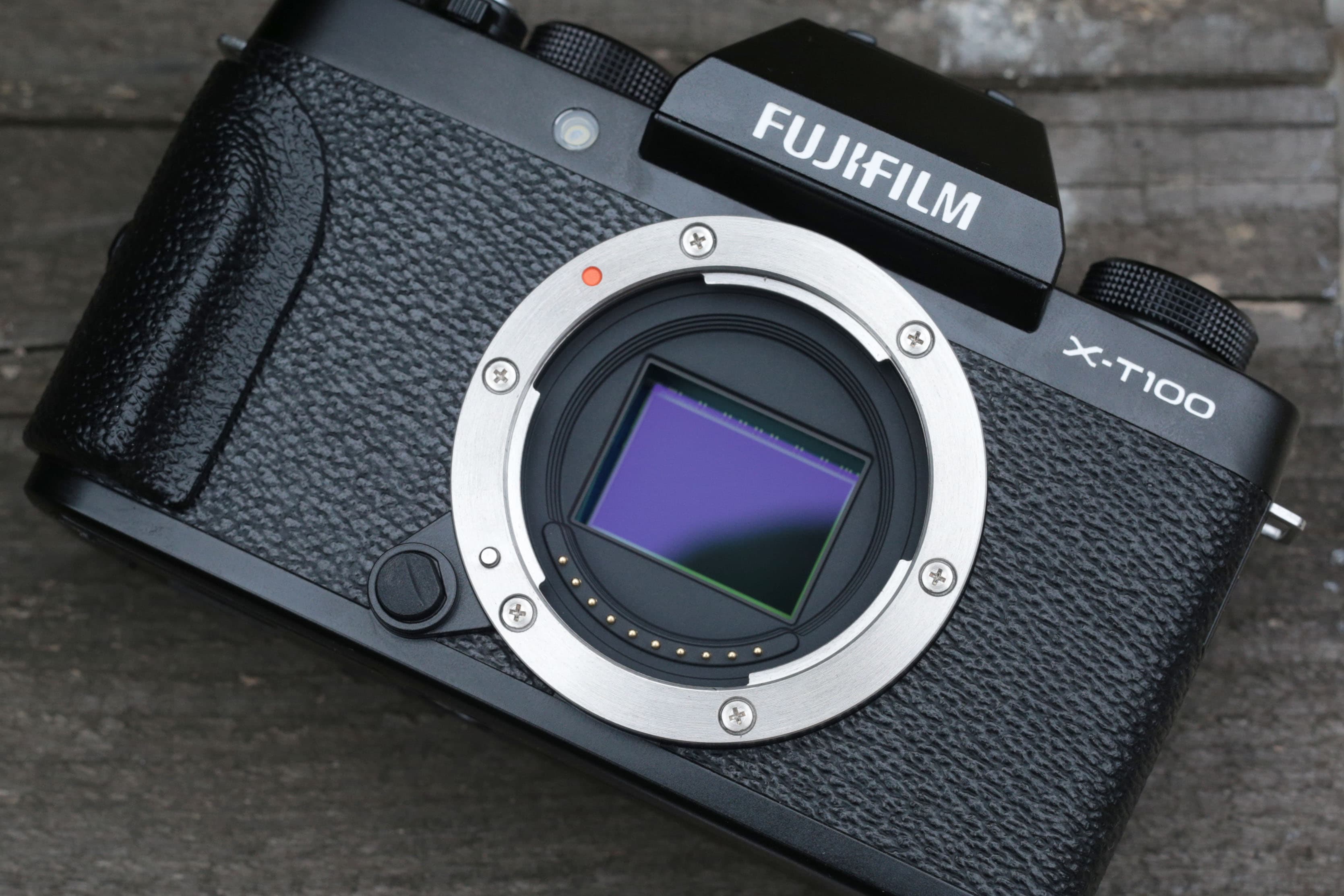
The X-T100 accepts Fujifilm X-mount lenses
The standard sensitivity range of ISO 200-12,800 can be expanded to ISO 100-51,200, albeit JPEG format only. Users can also setup three Auto ISO settings to a maximum of ISO 6400.
By now you will have clocked on that the X-T100 inherits a lot of what the X-A5 has to offer and this extends to its autofocus system. In total you get 91 AF points arranged in a 13×7 rectangular grid, with the central portion of 35 AF points being the sensitive phase-detection type.
You can choose from single-point AF, zone AF (using blocks of 9, 30 or 49 points) or a Wide/Tracking AF mode that employs all 91 points and can be used to track subjects through the frame. Focus modes include AF-S, AF-C and manual focus, with various Face/Eye detection settings also available.
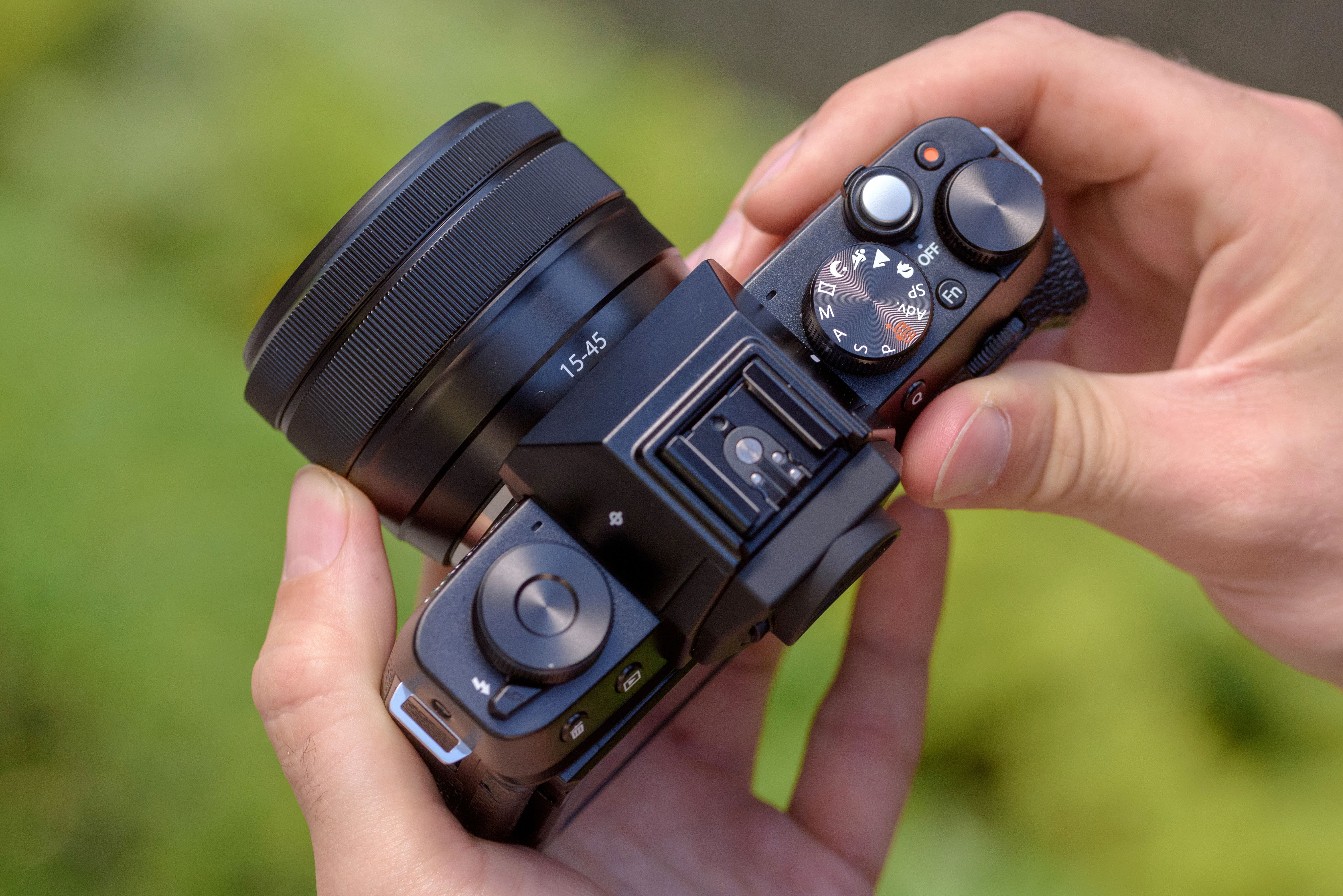
The top plate of the X-T100 is fairly basic and features three dials, including a mode dial
Fujifilm has kept things fairly simple on the top plate, choosing to equip the X-T100 with a mode dial and traditional PASM controls ahead of a dedicated shutter speed and exposure compensation dial.
Beginners who’d feel more comfortable shooting in auto before progressing to the manual modes can use the fully automatic Advanced Scene Recognition (SR+) mode, there are 18 advanced filter modes with a live preview and a great selection of scene modes – some of which (portrait, landscape, sport and night) get their own dedicated position on the mode dial. Added to this you get a panorama mode and eleven Film Simulation modes, though the newest Arcos and Eterna modes are both absent.
Two features likely to lure people to the X-T100 ahead of the X-A5 are its 0.39in, 2,360k-dot OLED electronic viewfinder and 3.0in, 1,040k-dot 3-way tilt LCD screen.
The EVF offers 100% coverage and 0.62x magnification, whilst providing dioptre adjustment and an eye sensor that can be used for automatic switching with the rear screen. The displayed information in the EVF automatically rotates depending on the shooting orientation and there’s a view mode button to cycle through various viewing options.
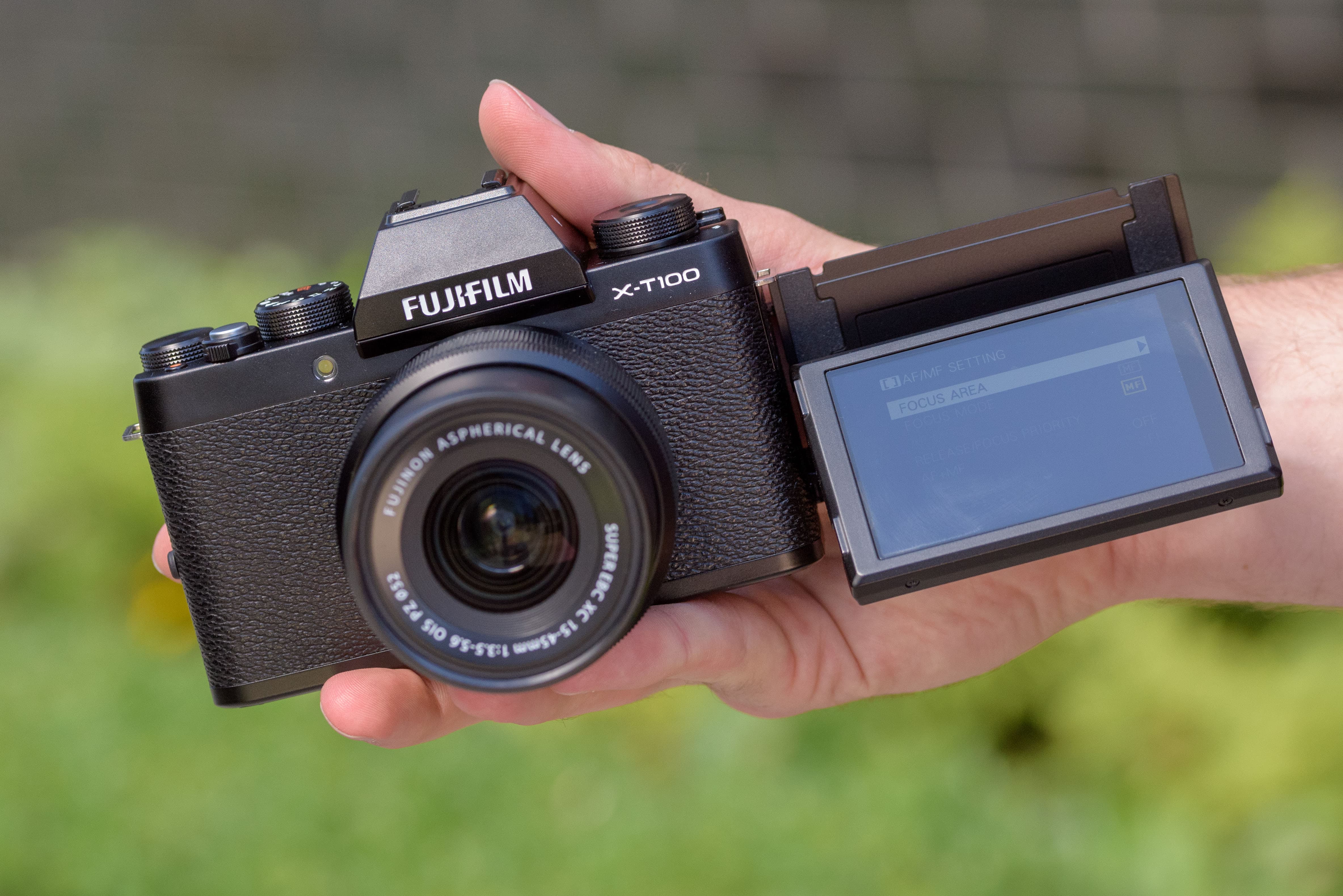
A view of the X-T100’s screen in a flipped out and tilted position
The screen is different to those we’ve seen on other X-series models. It flips up for low-angled shooting and down for overhead shots, with added benefit that it can be pulled out to the side to assist with self-portraits.
In addition to Wi-fi, the X-T100 features the same low-power Bluetooth connectivity that we first witnessed on the X-E3. This is designed to preserve battery life and make light work of connecting previously paired smartphones. You are still required to install Fujifilm’s free Camera Remote app that’s available for both iOS and Android.
As well as offering 4K recording at a measly 15fps, Full HD video at up to 60fps is available. Like other mirrorless cameras, the X-T100 presents the opportunity to extract an 8MP still image from a clip of movie footage in its 4K burst mode.
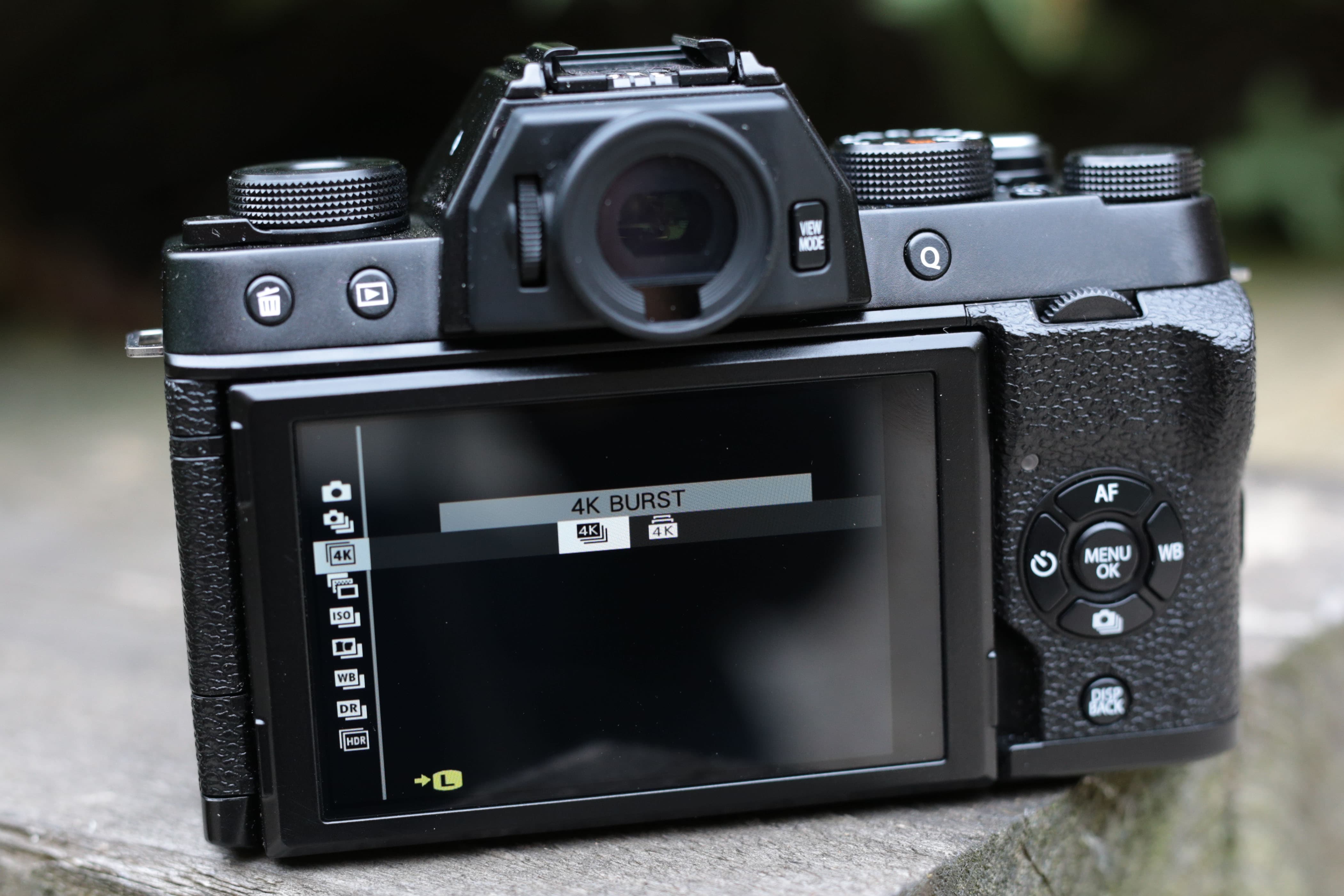
The 4K Burst mode is located from within the drive settings
The maximum continuous record time in any movie-recording mode is 30 minutes and there is a 2.5mm microphone port and HDMI (Type D) micro connector for anyone that wishes to improve audio quality or output movie footage to an external monitor. Lastly, the X-T100 accepts a single SD card beside its rechargeable NP-W126S battery, which has enough stamina for approximately 430 shots on a single charge.
Fujifilm X-T100 – Bluetooth Connectivity
To activate the X-T100’s bluetooth connectivity you first need to enter the connection settings via the main menu, select ‘Bluetooth settings’ and then click on ‘pairing registration’. From here you’re prompted to load Fujifilm’s camera remote app on your mobile device and select the pairing registration option.
After selecting X-T100 on your mobile device the camera will ask if you’d like to set the date/time from the smartphone. Confirm this and the Bluetooth setup process is complete.
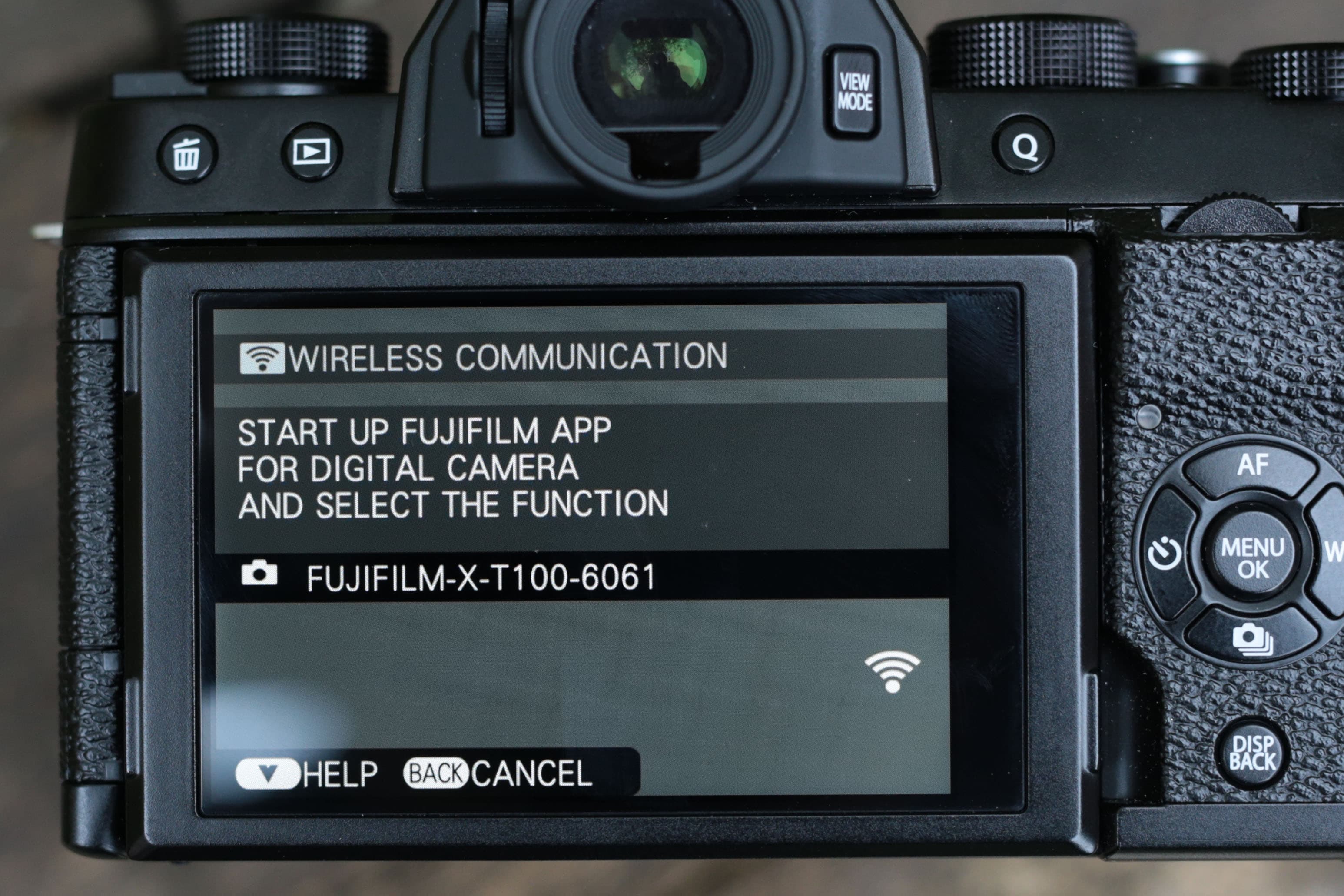
You’re prompted to start up the Fujifilm Camera Remote app from the camera
Each time the Camera Remote app is loaded from this point on the camera and mobile device automatically connect (provided Bluetooth on both devices is turned on) – a process that takes about five seconds after which the remote control, receive, browse camera and geotagging options in the app all become active.
These functions require a Wi-fi connection to work, but the good thing about Bluetooth is it initiates the Wi-fi connection faster provided your device isn’t already connected to a Wi-fi network. If it is you’ll need to go into the Wi-fi settings on the phone to switch the wireless network the phone is connected to before images can be transferred or remote control of the camera is taken.
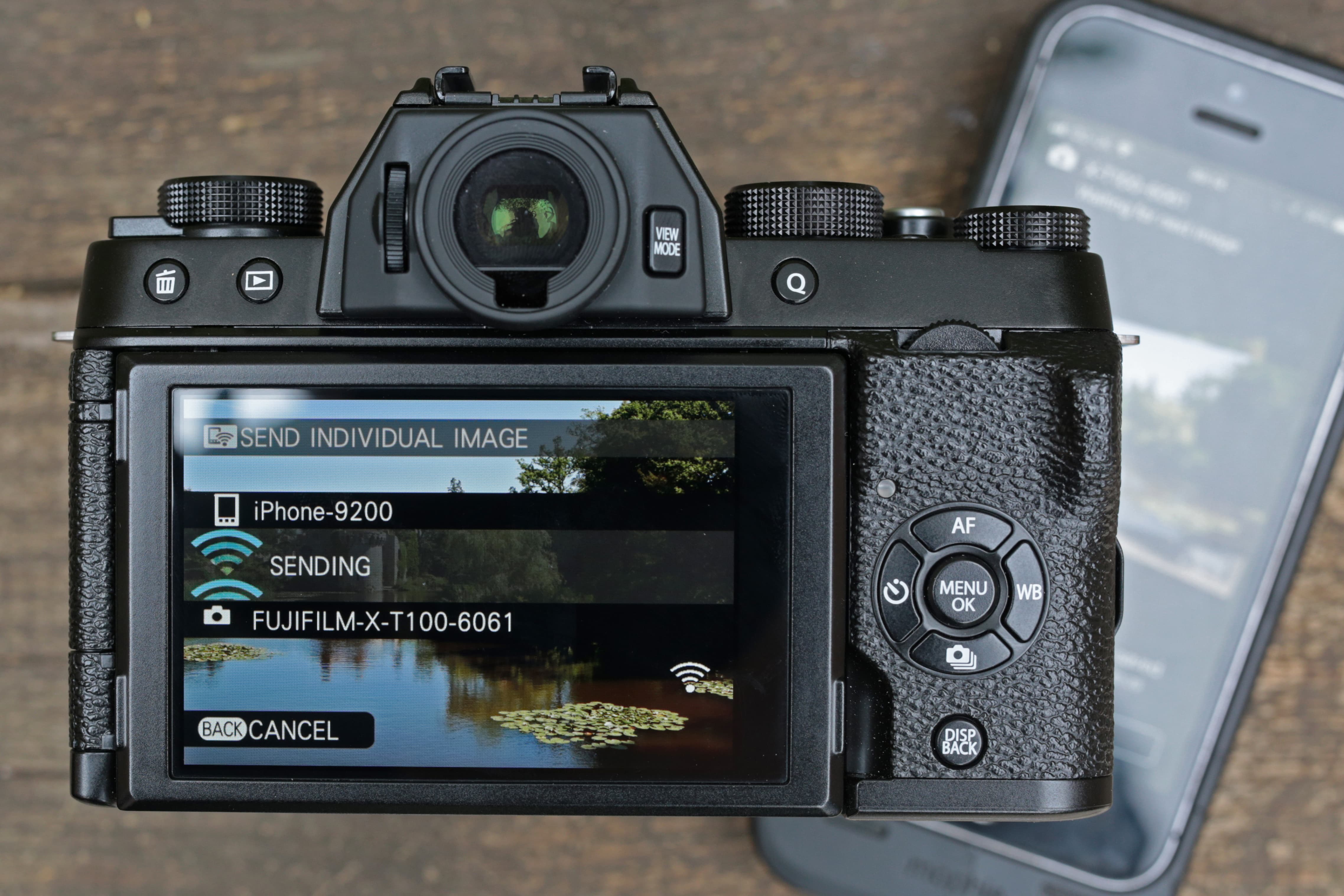
Wireless image transfer between camera and smartphone is quick and easy
As well as being able to customise the X-T100’s function button to wireless communication, this can be assigned to a swipe gesture on the rear screen. Users can also turn Auto Image Transfer On, which sends the last batch of captured images to the mobile device the next time a connection is established. A 3MP resize option can be selected and keeps file transfers quick while not filling up precious memory space.
Fujifilm X-T100 – Build and handling
The X-T100 has a strong resemblance with other X-T models, particularly the X-T20. It doesn’t have the same sculpted handgrip or the same high-shouldered design, but with its central EVF, three top plate dials and faux leather finish you can see where its design inspiration has come from.
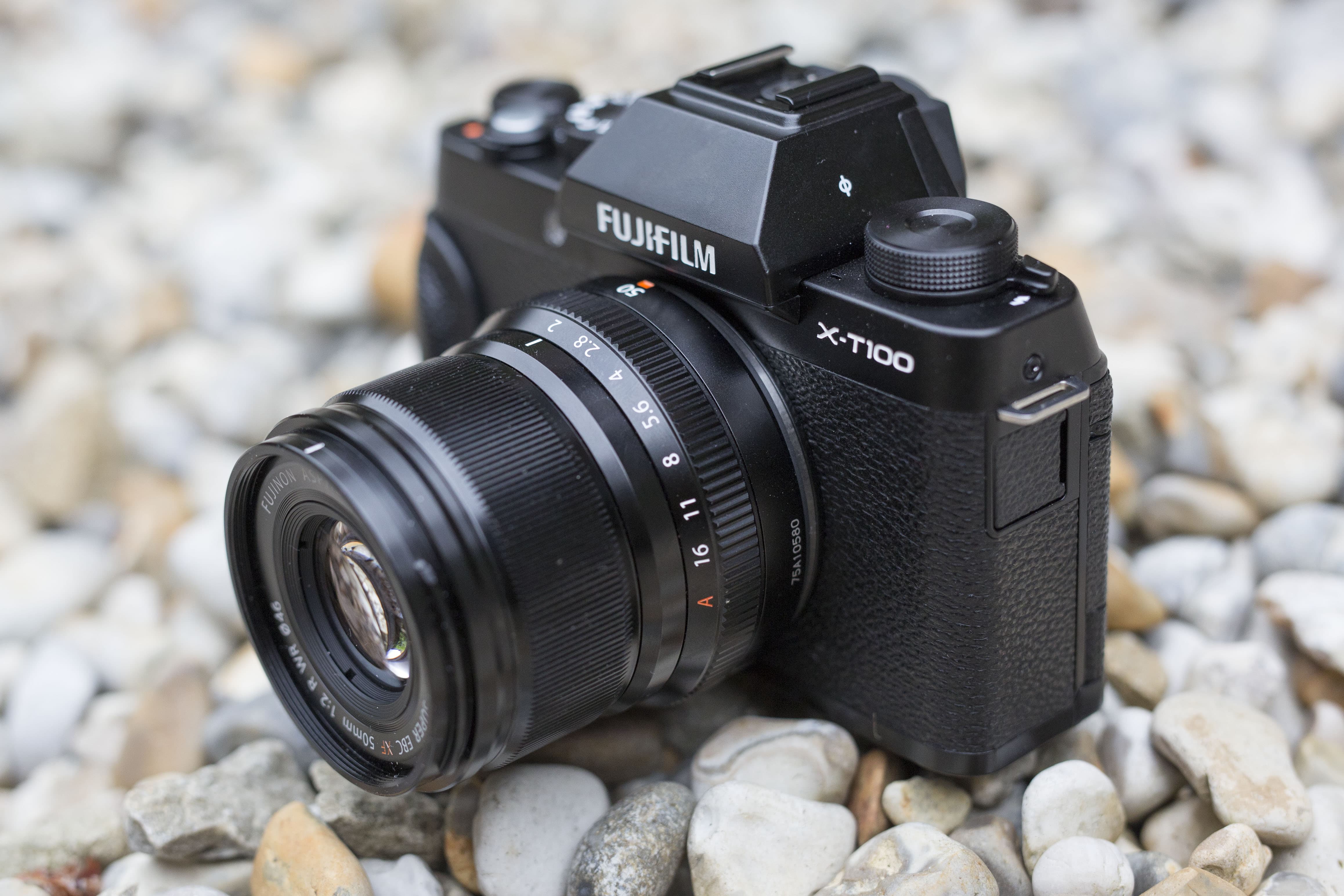
The X-T100 paired up nicely with the Fujifilm XF 50mm f2 R WR lens
Compared to the light, plasticky feel of the X-A5, the X-T100 has a more refined, solid quality about it. You’d think the X-T20’s magnesium alloy body would be heavier, but the X-T100’s aluminium and polycarbonate plastic body weighs 65g more. It has a surprisingly weighty feel for a camera of its size.
The front flat section of the body contributes to its pleasing aesthetics, but also sounds alarm bells about how it might feel in the hand without any form of protrusion to wrap your fingers around. Straight out of the box, the X-T20 is the more comfortable camera to hold.
Thankfully, the handling of the X-T100 can be improved by attaching a detachable grip, which is supplied in the box. This screws into the side of the body and transforms the feel tenfold. It makes you wonder why Fujifilm didn’t sculpt the grip like this from the start. It would have been nice to see a rubberised thumb rest at the rear too. As it is it’s made of hard plastic and can be prone to get slippery with wet or sweaty hands.
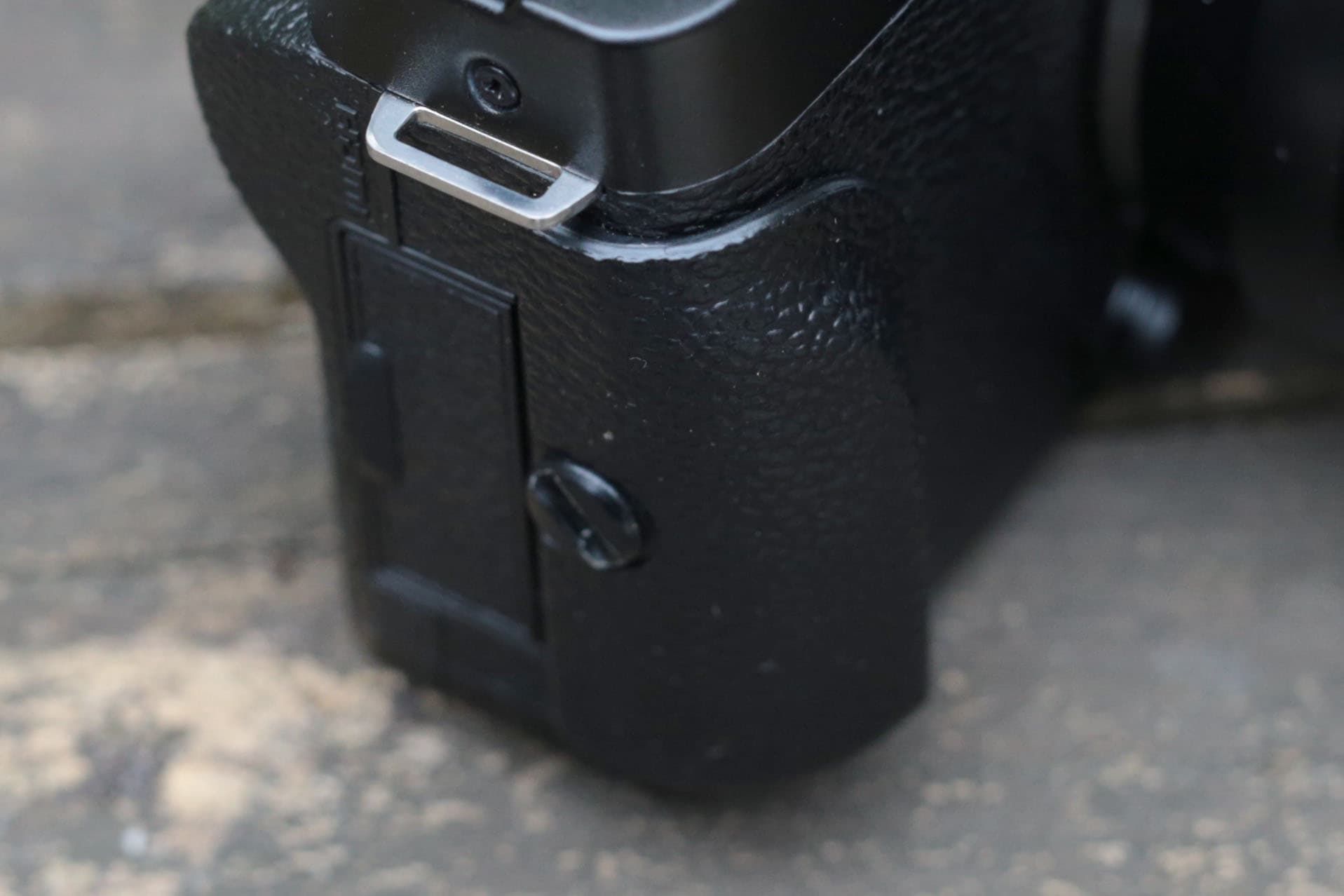
The camera comes supplied with a detachable grip that screws into the side of the body
Like many entry-level and enthusiast models, the X-T100’s buttons and dials aren’t weather sealed so you’ll want to be cautious in wet or humid environments. The top plate is stripped of the shutter speed, exposure compensation and drive dials we’re used to seeing on X-T series cameras.
In manual exposure mode the unmarked top plate thumb dial controls shutter speed, with the vertically mounted rear dial providing independent control of aperture. In program, shutter speed priority and aperture priority modes, the top plate thumb dial controls exposure compensation across a +/-5EV range.
In playback mode it can be used to scroll through images or you can use it to scroll through settings in the menu. The unmarked dial on the far left of the top plate is customisable to no fewer than 18 settings. Around its perimeter you’ll find a lever to raise the small pop-up flash.
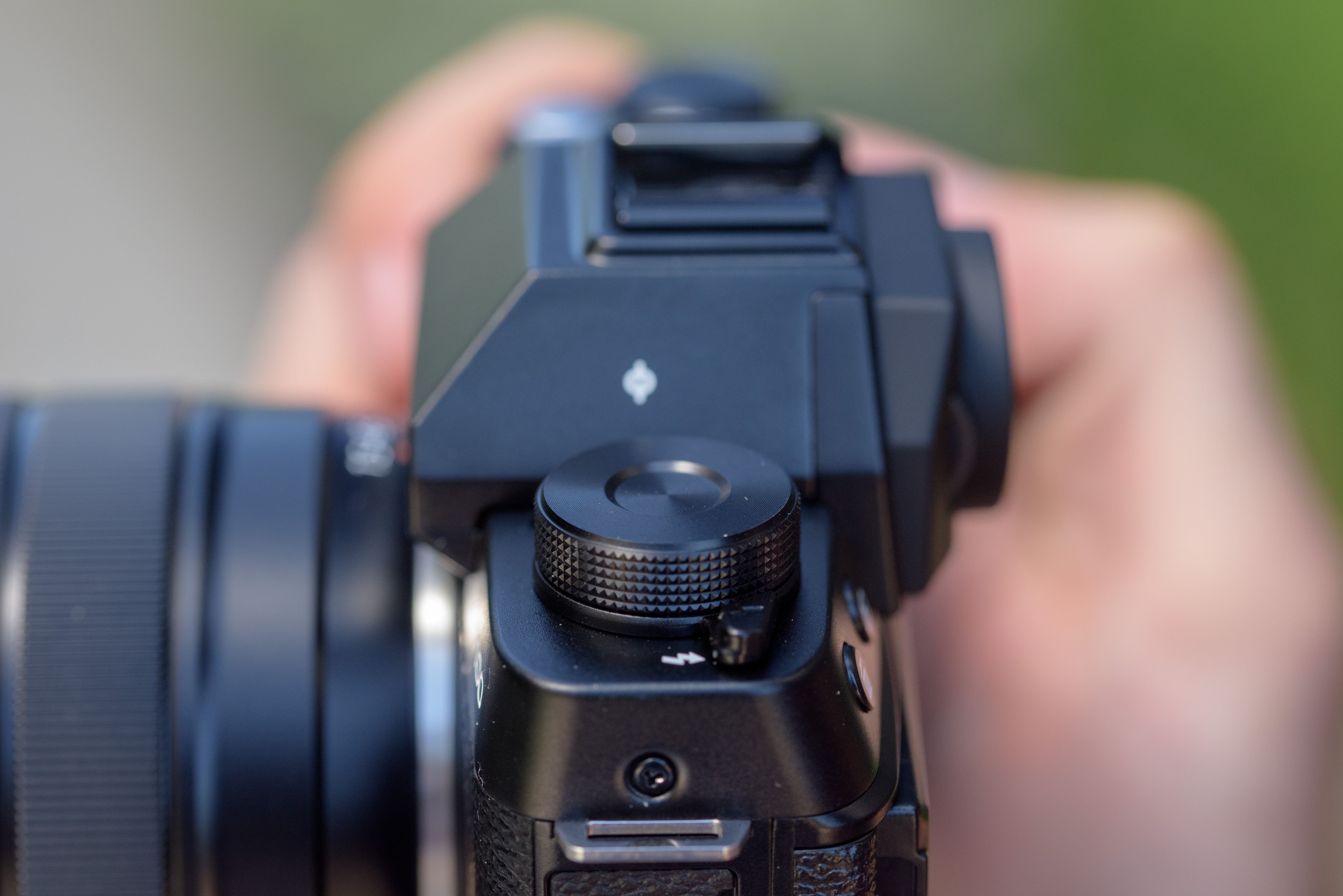
The customisable top plate dial and lever to raise the flash are clearly visible
The d-pad provides direct access to autofocus, white balance, drive mode and self-timer settings, while the ‘Q’ button above it loads a quick menu on the rear display to access a variety of commonly used settings. The quick menu can be customised, however it can’t be controlled by touch.
The employment of a mode dial, with direct access to a good number of auto modes, is befitting of its position in the market as a camera aimed at people wanting to take the jump from using a smartphone, or pursue photography more seriously as a hobby. To the right of it you get small function (Fn) and movie-rec buttons, with the On/Off switch encircling a non-threaded shutter button.
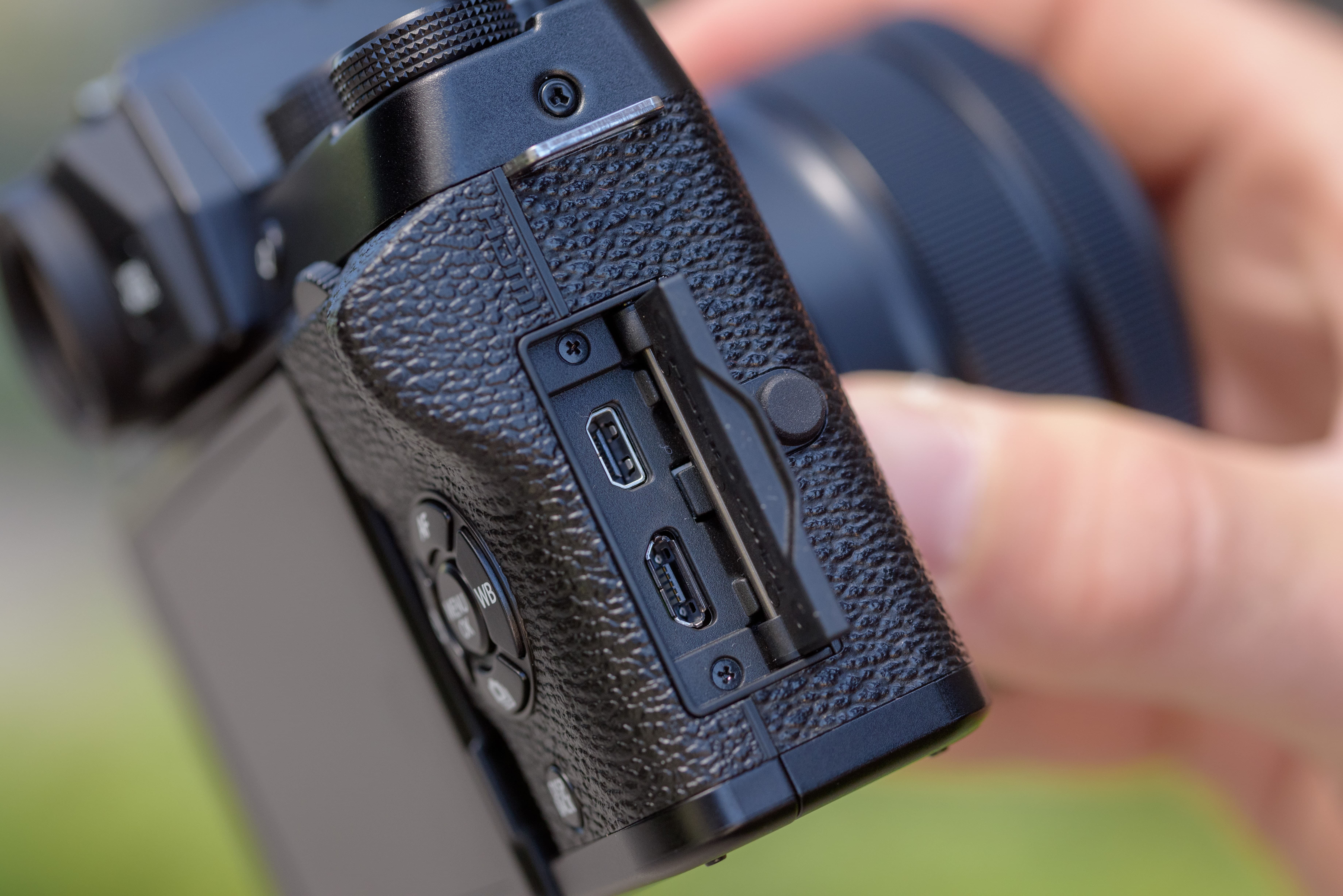
The X-T100 supports USB charging, allowing you to charge it up on the go
Despite only having one function button and one function dial, six custom functions can be set in total. It’s possible to assign four swipe functions to the touchscreen (up, down, left and right), however don’t expect the responsiveness of the screen to be as good as today’s smartphones or tablets. As I discovered, it’s not unusual to perform swipe gestures several times before they take affect.
While the X-T100 is an attractive little camera, you can identify the difference in build quality between it and more robustly made models like the X-T20 and X-T2. Unlike the X-T20, a metal handgrip to add a bit more bulk for those with large hands isn’t available. Being the size it is, it handles best with Fujifilm’s smaller lenses. It looks very stylish in graphite finish, but there’s also the choice of all black (like the review sample we were sent) or eye-catching champagne gold.
Fujifilm X-T100 – Viewfinder and screen
Having the option to raise the X-T100 to your eye and clearly see what’s contained within the frame and what isn’t gives it a huge advantage over cameras like the X-A5 that only offer a rear screen for compositional purposes.
On high-contrast days when sunlight can play havoc with glare and reflections it’s possible to set the view mode to either EVF only or EVF Only & Eye Sensor to take the rear screen completely out of the equation. The EVF shouldn’t just be looked at as just a compositional aid – it’s good for reviewing images in bright sunlight too, however you will notice there’s a momentary delay before each image is rendered sharp.
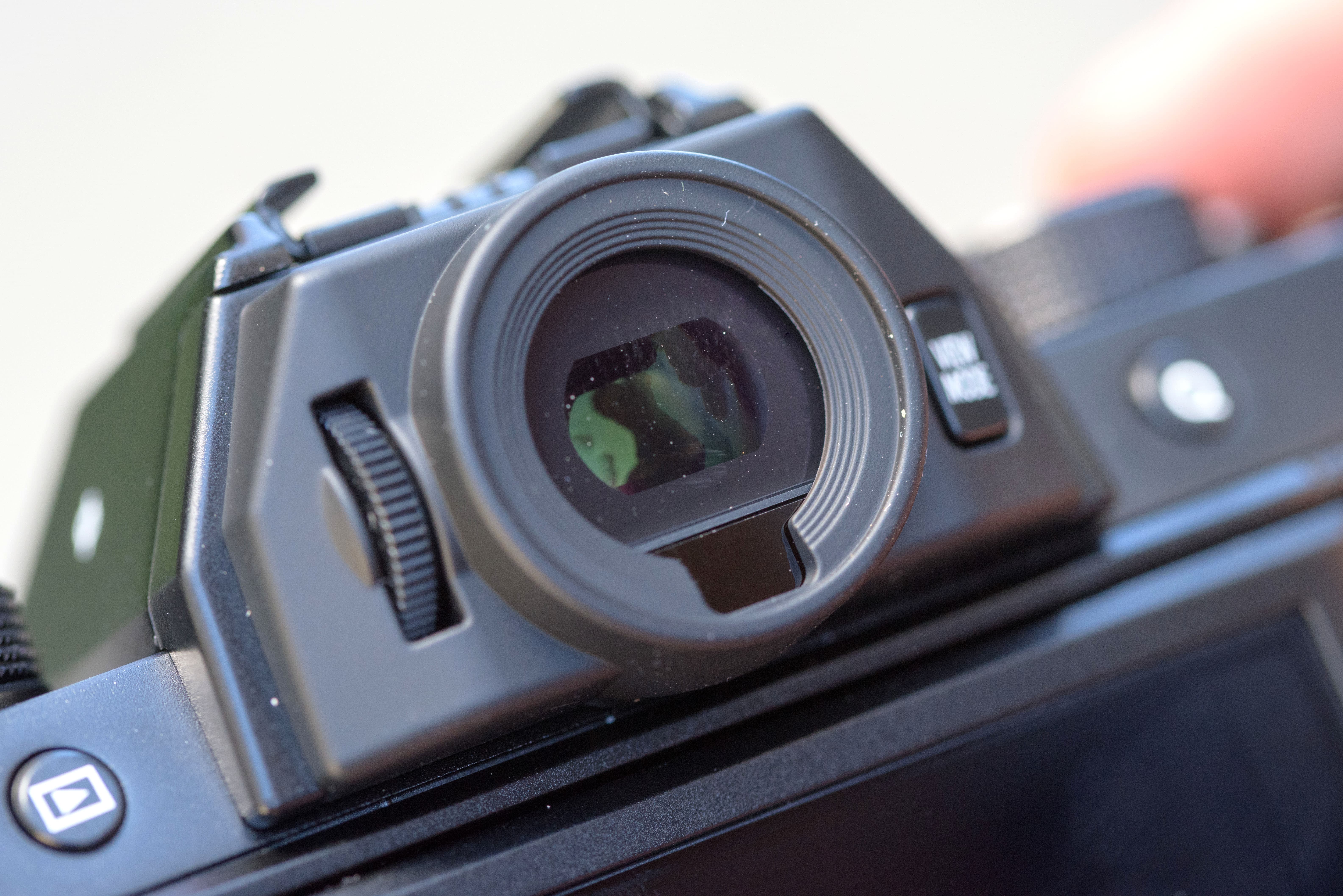
The eye-sensor automatically detects when the viewfinder is raised to your eye
It’s possible to reposition the AF point by moving your thumb over the screen’s surface at the same time EVF is raised to your eye. Double tapping the screen in the same manner loads a detailed magnified view. In use I found this functionality to be a bit hit and miss – sometimes it would register that I wanted to shift the AF point off centre whereas other times it wouldn’t. Hitting the AF button and shifting the AF point around using the dpad is the more reliable method for accurate autofocus.
Using the touch screen to tap between AF-S, AF-C and manual focus, pick a new film simulation mode or swipe through images in playback mode was more successful. Double tapping the screen in playback mode immediately loads a magnified view to check sharpness, however unlike some touchscreens we’ve seen of late it doesn’t magnify the precise area where you’ve double tapped and defaults to centre, meaning you need to use the dpad to navigate the image.
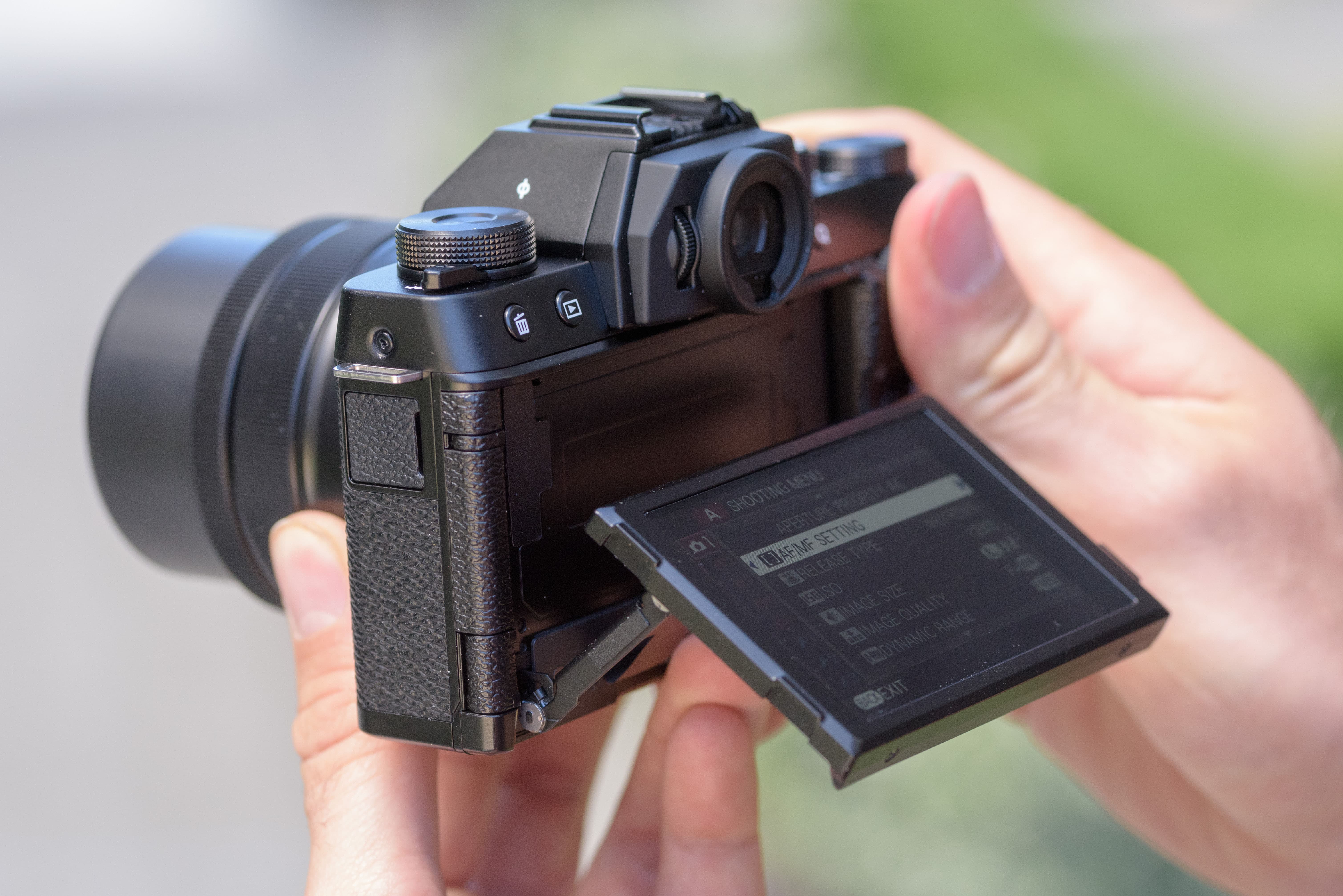
The screen can be angled upwards for low-level shooting
As for the manoeuvrability of the 3-way screen, it’s good that it can be angled out by 180 degrees to aid with self-portrait shooting. The caveat is that it doesn’t flip like a vari-angle screen, so you can’t compose any other type of image but a selfie in its pulled out position.
Fujifilm X-T100 – Performance
Other than a few criticisms regarding the responsiveness of the touchscreen and the effectiveness of its touch functions, the X-T100 is a reliable performer that you can rely on to capture great images, be it on your travels abroad or for use closer to home.
Although it may not have an X-Trans sensor, colour reproduction straight out of the camera is excellent. A majority of our test images were taken with the white balance set to auto and the film simulation mode set to Provia or Velvia. The camera served up faithful, vibrant colours with each and every shot.
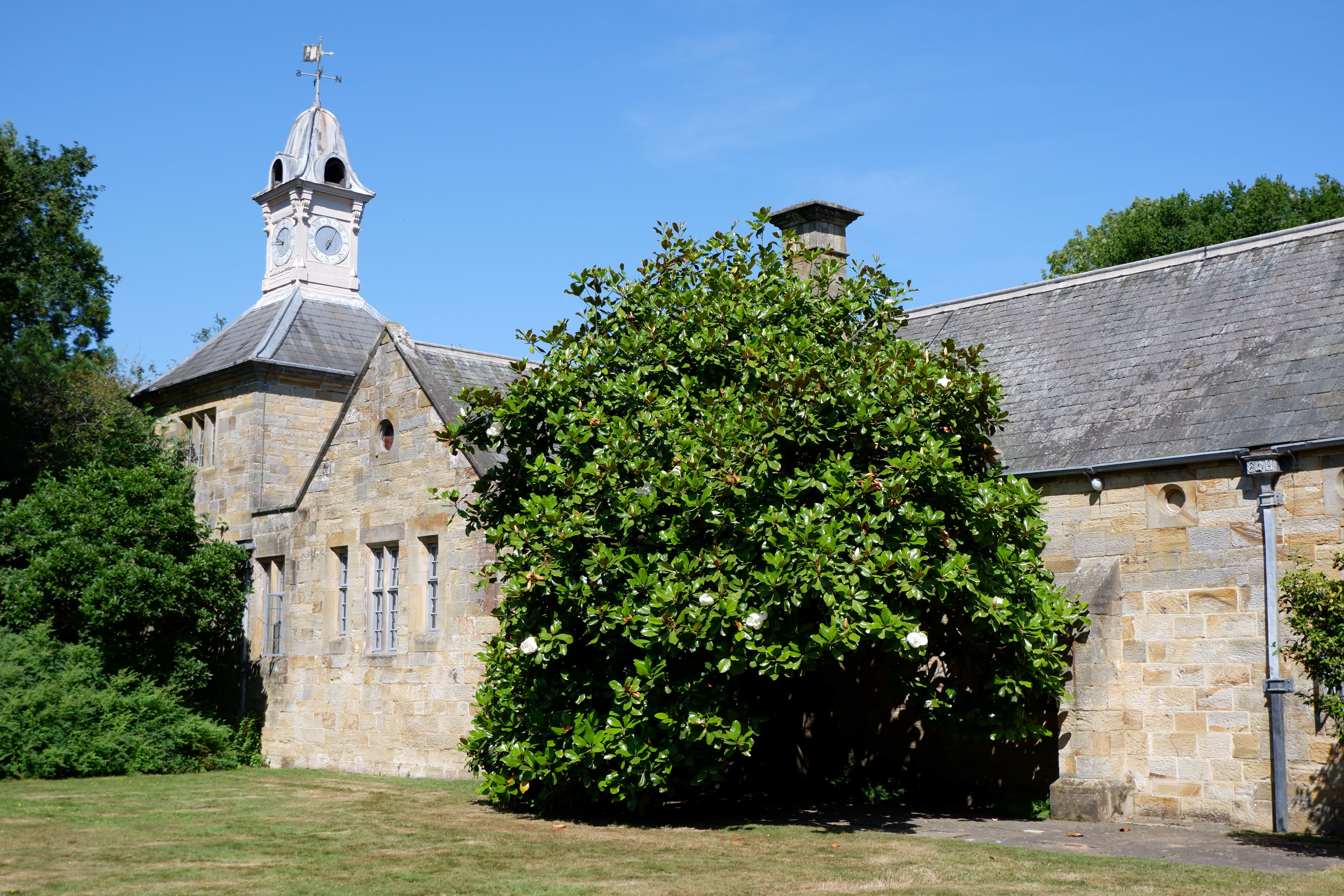
The sensor records excellent colour, producing bright, vibrant and faithful results
The tried and tested 256-zone metering unit rarely disappoints and delivered accurate exposures when it was challenged by dark indoor scenes and bright natural light outdoors. Only occasionally did I find that my images benefited from a tweak of exposure compensation. As we said when we reviewed the X-A5, there isn’t much to fault with the X-T100’s Bayer-array CMOS sensor at all.
The X-T100 provides accurate focus-lock on in bright lighting conditions and doesn’t disgrace itself in low-light environments. Anyone who’d like to photograph moving subjects will want to have a good understanding of its zone and wide/tracking modes, however users should know that the X-T100 doesn’t employ the same sophisticated AF-C algorithm and tracking modes that Fujifilm’s X-Processor Pro models have and neither does it offer the AF-C custom settings you get on the X-T20 or X-T2 to fine tune how the camera reacts to the way a subject moves within the frame.
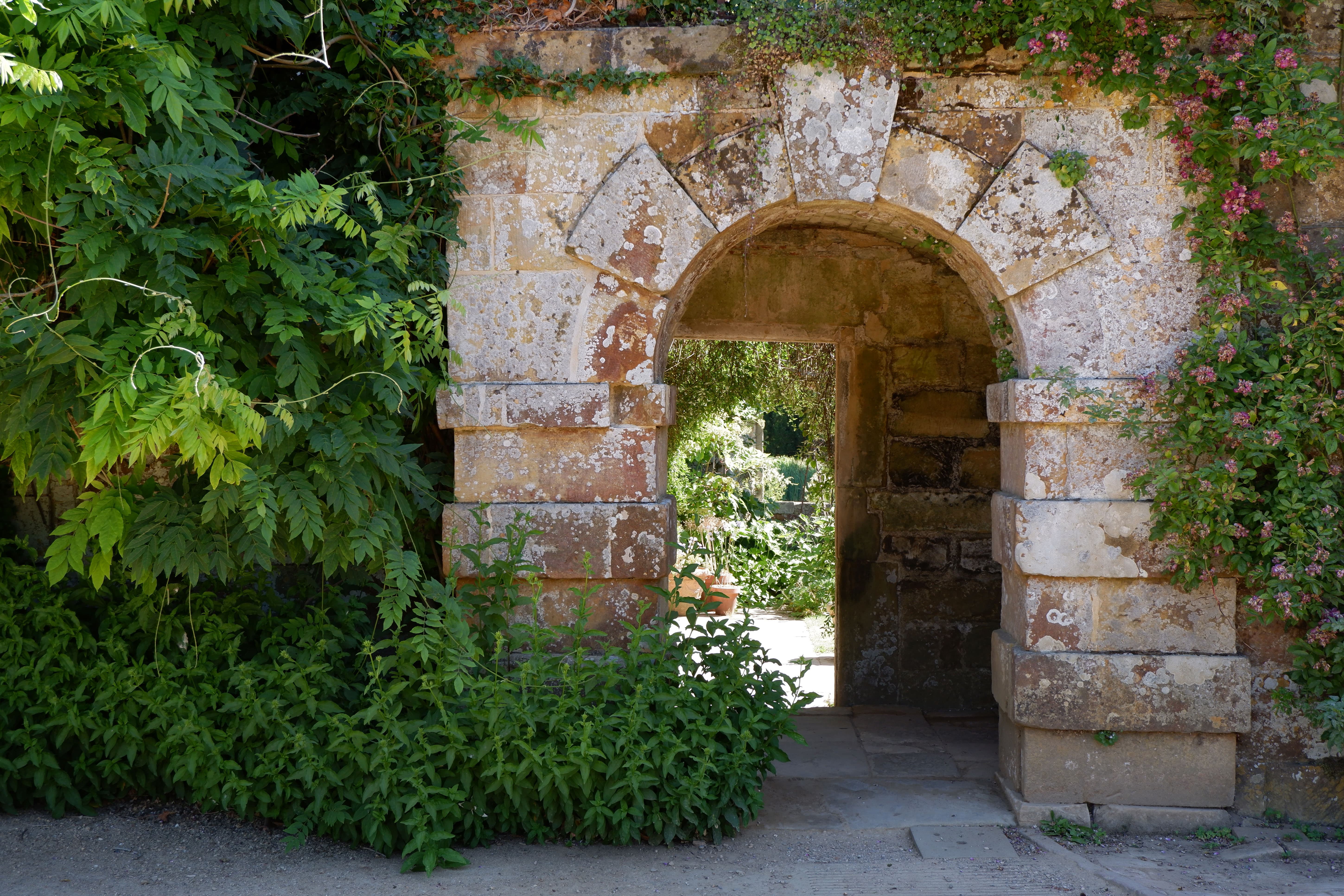
The metering system can be relied on to deliver excellent exposures in tricky scenes
The wide/tracking mode is best for capturing a subject that moves unpredictably up/down, left/right and closer/further from the camera, where you do not wish to move the camera around to chase the subject. Zone AF is more effective for shooting moving subjects when you’re prepared to move the camera with the subject. You’ll want to choose the zone size carefully from the 3×3, 5×5 or 7×7 focus area options, and with AF-C enabled, the camera will continue to refocus on your subject all the while the shutter button is half depressed. If you’d like to switch between the autofocus modes quickly you’ll want to set the AF mode to all. Hit the AF button at the rear and use the scroll dial above the thumb rest and it’s possible to cycle through all the AF modes and focus area settings at once.
The menu system of the X-T100 is more dated than you get on Fujifilm’s X-Trans III cameras. Settings are listed under shooting and setup icons at the side of the screen and there’s no My Menu setting to collate your most frequently used settings in one area.

An 8MP image extracted from a clip of 4K video using the X-T100’s 4K Burst mode
For those who’d like to shoot discreetly, there’s the option to take shots silently by activating the electronic shutter. This is also handy when you’d like to exceed the mechanical shutter’s 1/4000sec limit and push as high as 1/32,000sec using the electronic shutter, enabling you to easily shoot with wide apertures in bright lighting conditions.
The status screen that provides a general overview of all shooting settings is useful too, however you can’t view the remaining battery power as a percentage so you’ll want to observe its three-bar battery level closely. There is the option to charge the camera via USB. I lost count of the number of times I recharged the camera on the go in my car or via my portable USB power bank. When the green LED light goes out the battery is fully charged.

Users can crop in tightly when required and retain an excellent level of detail
The X-T100 is only available with the XC 15-45mm f/3.5-5.6 OIS PZ kit lens, which is Fujifilm’s first attempt at making a compact motorised zoom. It’s smaller than the older 16-50mm kit lens and features built-in Optical Image Stabilisation technology.
The lens extends by 24mm in length when the camera is switched on and it’s operated via two control rings: an inner one that operates the zoom in power assisted mode, and an outer ring that either acts as a focus ring when focusing manually or as a manual zoom control that alters the focal length in minute increments. It’s good the lens automatically reverts to the last focal length setting used when the camera is switched off and back on again, but its motorised nature does slow you down and the two-step process of using both rings to find the optimum focal length is a bit finicky.

Yet another example of the excellent colour produced by the X-T100’s APS-C CMOS sensor
The lens isn’t the quietest zoom in operation either. Users should know that the built-in microphone picks up the whirring that occurs whilst zooming and focusing during video recording. Optically it delivers sharp results and the fine detail it resolves paired with the X-T100’s 24.2MP sensor won’t disappoint.
Fujifilm X-T100 – Image quality
The combination of Bayer APS-C CMOS sensor and newly developed image-processing engine is the same pairing as used within the Fujifilm X-A5. It’s no great surprise that the image quality results are identical to those previously recorded by its entry-level cousin. By opting to use the Bayer colour pixel array rather than the more complex X-Trans pixel array, Fujifilm has been able to make the X-T100 more affordable than the X-T20. This ultimately comes down to the Bayer sensor being a less expensive component. The X-T100 like the Fujifilm X-A5 does not have a low pass filter.

An excellent level of detail is preserved high into the ISO range. This shot was taken at ISO 3200
Fujifilm X-T100 – Resolution
Like 24MP Bayer sensors we’ve tested in other Fujifilm cameras in the past, the X-T100 is capable of resolving fine detail, with a good amount of scope to crop in when required. The X-T100 resolves a maximum of 3,200l/ph between ISO 100 and ISO 400, with resolution dropping slightly at ISO 800 to 3,000l/ph. Detail holds up well beyond ISO 800 and only starts to dip below 3,000l/ph when you push past ISO 3200. The detail resolved at ISO 6400 and ISO 12,800 (2,800l/ph) is good too, but you will start to see detail reducing more abruptly at its extended ISO 25,600 and ISO 51,200 settings where you’re restricted to shooting in JPEG format only.
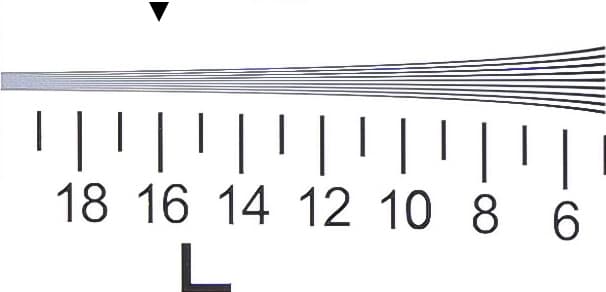
Fujifilm X-T100, JPEG, ISO 100
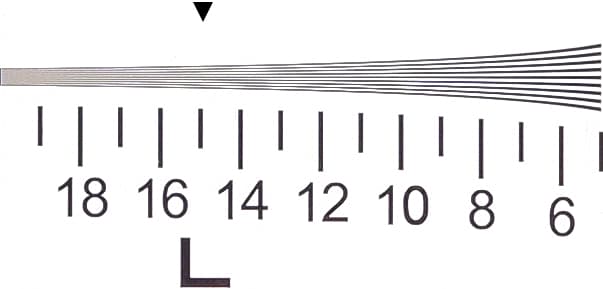
Fujifilm X-T100, JPEG, ISO 1600
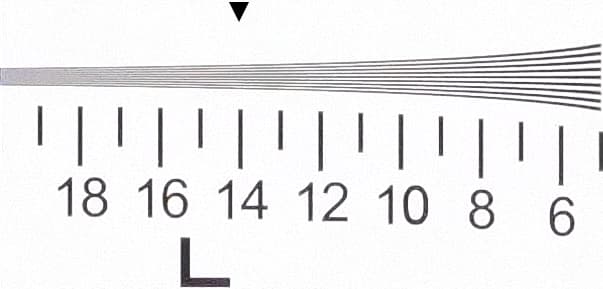
Fujifilm X-T100, JPEG, ISO 12800
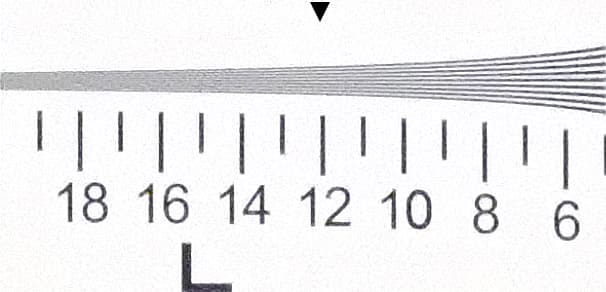
Fujifilm X-T100, JPEG, ISO 51200
Fujifilm X-T100 – ISO and noise
The X-T100 provides excellent JPEG results between ISO 100 and ISO 1600, beyond which point you’ll start to notice in-camera noise reduction beginning to soften the finer details in an image. Set the sensitivity to ISO 1600 or above and you’ll want to shoot in raw for the best results. Noise is very well controlled at ISO 3200, and though it’s more obvious in raw files captured at ISO 6400, it’s not offensive to the point it’ll stop you using it in a low-light situation. Pushing to ISO 12,800 introduces increased noise, but could be used in an emergency if it’s a toss up between capturing a subject sharp over it being blurred. Entering the expanded settings is where the noise performance starts to go downhill rapidly so be prepared to avoid ISO 25,600 and ISO 51,000 at all costs.
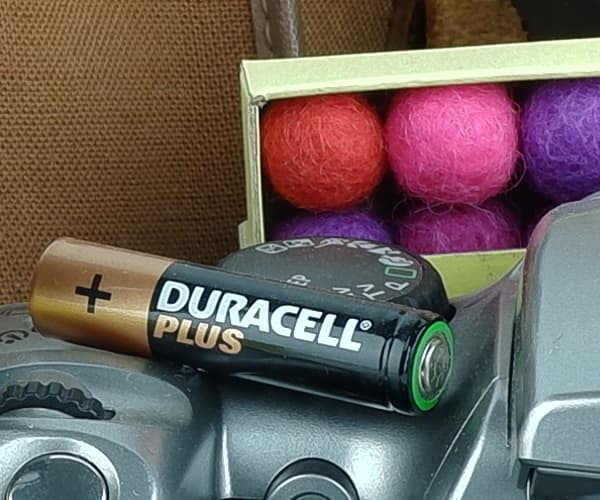
Fujifilm X-T100, JPEG, ISO 100
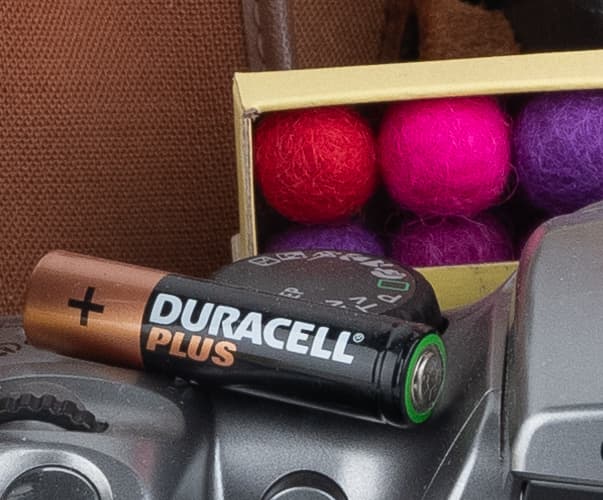
Fujifilm X-T100, RAW, ISO 400
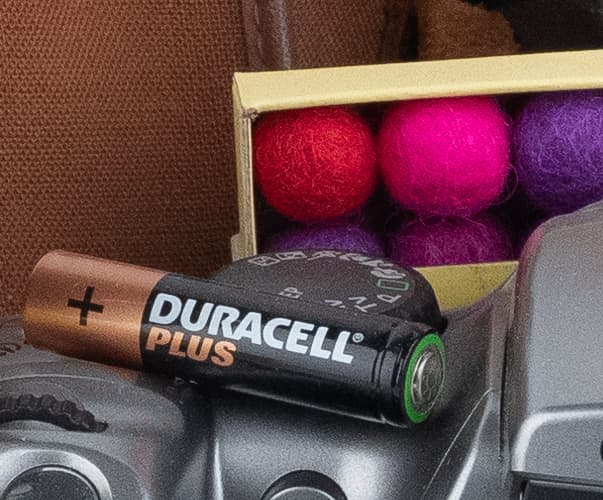
Fujifilm X-T100, RAW, ISO 1600
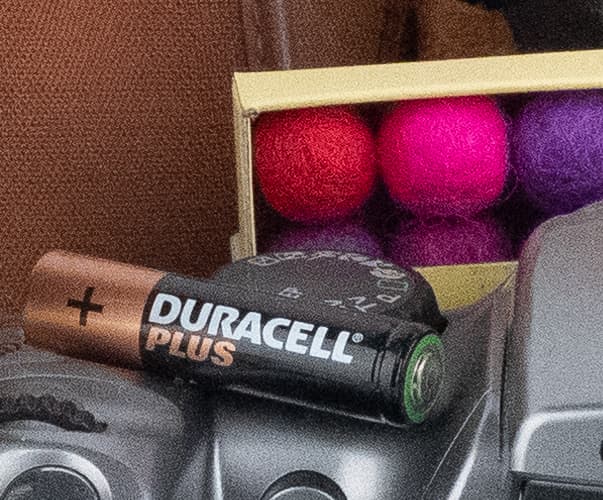
Fujifilm X-T100, RAW, ISO 6400

Fujifilm X-T100, JPEG, ISO 25600

Fujifilm X-T100, JPEG, ISO 51200
Fujifilm X-T100- Verdict
The X-T100 slots into Fujifilm’s desirable X-T series below the X-T20 where there’s been a gap for a more affordable entry-level model for quite some time. As a camera designed for first-time mirrorless buyers and those advancing from smartphones, it’s very appealing, from both an aesthetic and performance perspective.
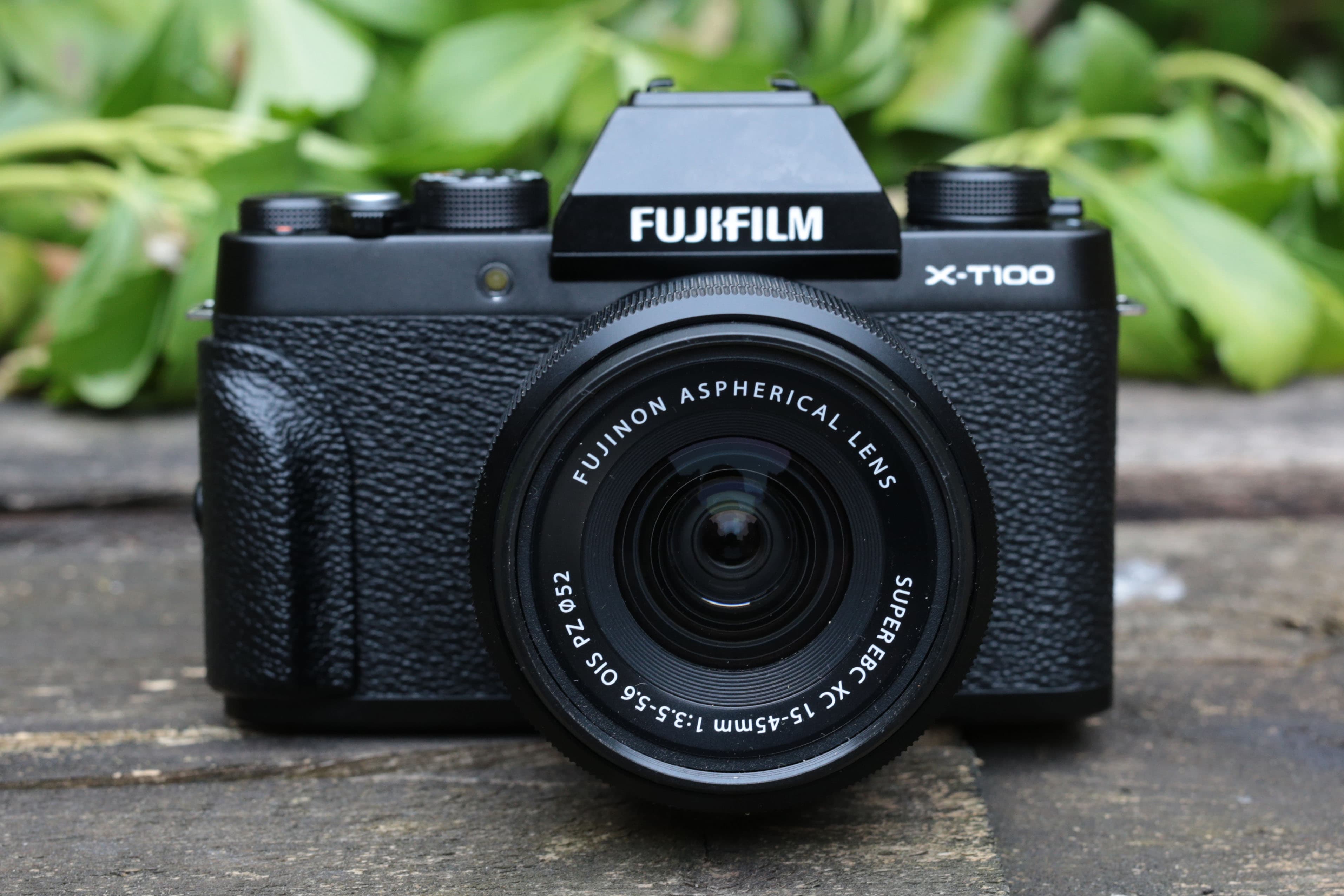
The X-T100 with the supplied screw-on handgrip attached
It feels solid in the hand, more so than Fujifilm’s X-A5, provides a centrally positioned EVF to assist composition, and serves up the advanced features one needs to hone shooting skills after exploiting the various auto modes. Is it worth spending £120 more for the X-T100 over the X-A5? Having used both extensively, I’d say it’s a small price to pay for the added benefit of an electronic viewfinder and its lovely SLR styling.
Those who do buy it will fall in love with its form factor and the quality of the images it produces almost instantly. Despite not having an X-Trans sensor, it delivers very impressive image quality, with vibrant colour and excellent detail preserved high into its ISO range.
As positive as all this sounds, it does have some cons. The touchscreen isn’t as well implemented as other entry-level mirrorless models, the low frame rate in 4K movie mode produces poor, stuttery footage that’ll force you to record videos in Full HD, and the motorised kit zoom is a bit loud and pesky.

The 15-45mm kit lens that’s sold with the X-T100 puts in a good optical performance
The good news for those who outgrow the kit lens quickly is that there are 26 X-mount lenses to choose from and when it’s used with Fujifilm’s lovely f/2 primes it takes up very little space at all.
With regard to looks and styling, the X-T100 is arguably the most attractive entry-level camera on the market at its price point. You do get a lot of camera for your money, but the same can be said for the Canon EOS M50 and Olympus OM-D E-M10 Mark III, which challenge it hard. To sum up, the X-T100 is an excellent gateway to Fujifilm’s X-T series and will serve first-time mirrorless buyers well.








